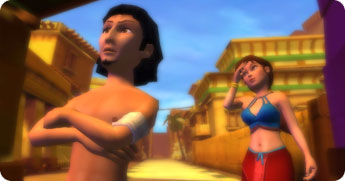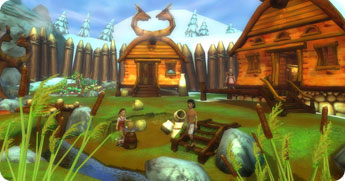- Site: Ankh: Battle of the Gods
- Publisher: RuneSoft
- Developer: Deck13 Interactive
- Genre: Adventure
By Brad Cook
It’s the comeback story of the year. Heck, it’s the comeback story of the millennium. Horus, god of the sky, was thought long gone until he turned up in the most unlikely of places: living inside the infamous ankh necklace worn by that bumbling slacker Assil. Or perhaps, through some divine comedy understood only by the gods, it was the most likely place for Horus to arrive, and Assil’s destiny was foretold the day a mummy placed a death curse on him.

Assil managed to defeat that curse, and he even retrieved the ankh after it was taken from him (nearly losing his long-time love Thara in the process), but his latest adventure could be his — and mankind’s — undoing: Seth is favored to win the upcoming once-in-a-millennium Battle of the Gods, and if he manages to do so, he’ll plunge the world into darkness and chaos. Horus is the only god who can defeat him, but he’ll need Assil to carry the ankh into position to deliver a victory.
And Assil will need help from another pantheon’s god — Thor — if he wants to succeed. The Ankh series is a multi-pantheon affair, of course.
Puzzling Situations
Ankh: Battle of the Gods takes Assil from Cairo to Luxor, capital of ancient Egypt, and eventually to the Hotel of the Gods — from there he travels to the Viking village where Thor lives and returns to the Hotel for the climactic contest. Against her better instincts, Thara accompanies him on his latest madcap adventure. At least Horus offers some advice along the way.
As in the previous two games in the Ankh series, you navigate conversations with NPCs (non-player characters), some of who don’t always want to give him what he wants, at least not right away. You may need to try a discussion several times and pursue different options before striking the right one. Don’t forget to switch between Thara and Assil when necessary — the pair can share inventory items with each other, even if they’re not in the same room, and each has strengths and weaknesses, such as Thara’s swimming ability and Assil’s fear of water.
The items you collect need to be used alone or in combination with each other to solve puzzles, and sometimes the solutions come about in not-so-obvious ways. We bet you never considered using a fake shark fin with an ironing board to create a surfboard that will help you escape a flooded room. If you have, well, you may want to consider a career as an Egyptian slacker. It’s dangerous and unpredictable, with low pay and few benefits, but at least you’ll have a lot of fun.
Game Hardware
Check out our systems for your best gaming experience.

Hot Wheels. You might be able to somehow use that chariot.

Nordic Thunder. Thor will want Assil to prove his manliness. That’s a first for him.
If you liked these games, check out:
System Requirements:
- Mac OS X version 10.5.7
- 1.6GHz Intel processor
- 512MB of RAM
- 1.1GB hard disk space
- 128MB video RAM (Nvidia GeForce 7300 or ATI Radeon 2400HD or better)



Tips and Tricks
- Press X to see what you can interact with in a room.
- While Assil or Thara is walking somewhere, double-click to make them run.
- Go into the game’s settings and switch on fadeable inventory, which makes it easier to access items.
- Press the tab key to see current tasks.
- Skip film scenes with the spacebar; click the mouse during conversations to skip to the speaker’s next sentence.
- Don’t forget that Thara and Assil can talk to each other while you’re in control of one of them. Initiating some banter between them may give you clues if you’re stumped.
- If you get stuck, check out this handy walkthrough to figure out what to do next.
The History of Adventure Games’ Twisty Little Passages
The first computer adventure game was the text-based Colossal Cave Adventure, also known simply as Adventure. Based on Kentucky’s Mammoth Cave system and created by experienced spelunker Will Crowther in 1976, Adventure ran on mainframe computers and inspired many players to modify its gameplay. It later appeared on various home computers; you can even run it on Mac OS X or on a clickwheel iPod through the Notes function.
Adventure was the catalyst for the adventure game sub-genre known as interactive fiction, the most popular of which was the Zork series and Douglas Adams’ Hitchhiker’s Guide to the Galaxy. The game also inspired many software developers who would go on to leave their mark in the adventure genre, including Warren Robinett, who created the popular Atari 2600 title Adventure, and Roberta Williams, who founded On-Line Systems, later known as Sierra On-Line, with her husband Ken.
Sierra helped popularize graphical adventure games, including the classic King’s Quest and Leisure Suit Larry series, paving the way for a pair of important events during the late 1980s and early 1990s: LucasArts’ introduction of the ability to click on words and objects to produce results, rather than having to type commands into a game, and Cyan’s publication of Myst, which took adventures into a photo-realistic world full of lush, exotic environments.
As computers’ graphical capabilities improved during the years since then, adventure games have produced increasingly elaborate worlds and stories for us to explore and experience. The Ankh series, Jack Keane, The Abbey, and A Vampyre Story, among other similar titles, have continued to expand the point-and-click gameplay — and funny stories — introduced by LucasArts, while Myst V: End of Ages, the Penumbra series, and other adventures have further developed the gameplay style introduced by Myst.
Horus vs. Seth: A Twisty Little History
Ankh: Battle of the Gods’ tale of dueling deities has a basis in Egyptian mythology, with stories found on walls, coffins, and other relics of the ancient world detailing the conflict between Horus and Seth (also known as Set). In most of the myths, Horus is the son of Osiris, a wise king who was married to his sister, Isis, and had brother named Seth.
Seth was jealous of Osiris and killed him by various means, depending on which story you read. (Tricking him into lying down in a coffin and then sealing the box with lead and throwing it in the Nile River was a popular version of the assassination.) Isis, however, was able to resurrect Osiris for a brief while, and he impregnated her. She gave birth to Horus, who decided that his father’s enemy was his enemy. Thus the mythological feud between Horus and Seth was born, and Osiris went on to become god of the dead and history’s first mummy.
Like many such stories, that conflict likely had some basis in historical fact, since Egyptian mythology says that Upper Egypt was given to Set and Lower Egypt was bestowed on Horus, with all of Egypt eventually handed to Horus. However, when Upper and Lower Egypt fought, the former conquered the latter, although it’s possible the myth was actually describing a conflict between followers of Horus and Set in Upper Egypt. After Upper and Lower Egypt united, Horus and Set were typically shown as allies who jointly crowned new pharaohs.
